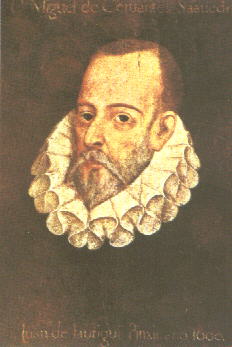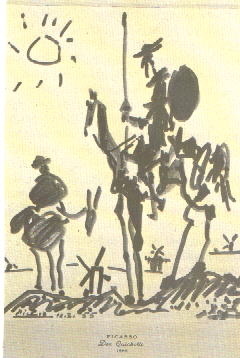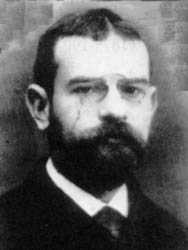SCHEDULE OF ASSIGNED
READINGS
First week:
General Introduction:
"The Story of Spain: Land of Cultures"
Second week:
El
Cid , Anonymous (no reference in our books [= nriob])
Click to read the
digital version of this book at the UC-Berkeley
Gonzalo de Berceo
[nriob]. See the translation of his "Introduction"
to Milagros de nuestra señora.
Read M. J. Kelley's
article "Blindness
as Physical and Moral Disorder in Berceo,"
Don
Juan Manuel (in Flores, 2-11)
Juan Ruiz, Arcipreste
de Hita [nriob]
Jorge de Montemayor
(in May, 8-45) [Read this article: Abencerraje]
[Consult the Internet
Medieval Sourcebook for a wealth of information on the period]
Third week:
Lazarillo (in
Flores, 12-61) [You can read a bilingual edition of Lazarillo
online]
Cervantes ("The Wedding..."
in May, 124-157) [Read Cervantes' brief bio]

[Read
this article by Peter
Dunn comparing Cervantes' work with the picaresque novel]
Fourth week:
Cervantes, Exemplary
Novels
Introduction, 7-18
"The
Little Gipsy Girl," 19-84 (Click here to learn about the gipsies)
"Rinconete and Cortadillo,"
85-120
"The Power of the Blood" (in Flores, 62-89)
Fifth week:
Cervantes, Exemplary
Novels
"The Glass Graduate,"
121-146
"The Jealous Extremaduran,"
147-180
"The Deceitful Marriage,"
181-194
"The Dogs'Colloquy,"
195-252
[Visit
the site of the Cervantes
Society of America and read hundreds of articles on Cervantes's work]
[Margaret
Greer looks at the work of Cervantes and Zayas and compares their "framing"]

Sixth week:
First Exam (first
part of the class)
Bécquer
(in May, 46-75)
[Click
here for an article on Bécquer's "feminine writing" or here
to read some of his Rimas]
Key
ideas of the Romantic
movement and the Oxford
Dictionary definition. Unfortunately the Spanish Romantic movement
does not have a good presence on the web. Click here for selected
electronic texts in English.
Three
essential texts on Romanticism: Schiller
(German), Baudelaire
(French), Shelley
(English).
Seventh week:
Alarcón (in
Flores, 90-103)
Bazán
("Revolver" in Flores, 116-127; "Dream Story" in May 76-85)
Emilia Pardo Bazán
and Leopoldo Alas, "Clarín" are the key figures of Spanish Naturalism.
We don't have much on the web, but learn here about key ideas of Naturalism.
Eigth week:
 Clarín
(in Flores, 128-145) & Unamuno
Clarín
(in Flores, 128-145) & Unamuno
("The Marquis" in
Flores, 146-175; "A Story of Love" in May, 86-123)
Ninth week:
Cela
(in Flores, 238-257)
Goytisolo
(in Flores, 258-275)
Tenth week:
Masoliver, editor,
"Introduction"
Saladrigas,
Moix, Vázquez Montalbán, Tomeo, Marías, Millás,
Riera (1-63)
Eleventh week:
Merino, Pombo, Tusquets,
Vila-Matas, Monzó, Fernández Cubas, Díez, Puig.
(Masoliver,
64-119)
Twelfth week:
Puértolas,
Murillo, Martínez de Pisón, García Sánchez,
Díaz-Mas,
García
Montalvo, Muñoz Molina (in Masoliver, 120-149)
Thirteenth week:
Pamies, Zarraluki,
Cercas, Millán, Freixas, Cerezales, Atzaga
(In Masoliver,
159-201)
Fourteenth week:
Conclusions
Last Exam [4:30-7:10
PM]